Picture this: an Amazon free of new hydroelectric plants and high-speed roads but with millions of hectares of restored native forest and an appreciation for the way of life of those who live in harmony with the forest; an Amazon that reduces Brazil’s greenhouse gas emissions and shares with the rest of the country the climate benefits of halting deforestation; an Amazon that creates more jobs and income for its people.
This vision, which began as a utopian dream, is now a solid proposal. Based on a newly released report entitled New Economy for the Brazilian Amazon (NEA), the result of two years of work by seventy-six Brazilian researchers, the proposal could be a reality by 2050 if a political decision were made to set things in motion now. While some may have reservations about certain points in the report, the question about how we can prevent the planet’s largest tropical rainforest from reaching the point of no return finally has a solid answer – and one that is doable.
Scientist Carlos Nobre, a leading scholar on how the Amazon rainforest contributes to balancing the world’s climate, suggested the idea of the study to the World Resources Institute (WRI). This international organization had already mobilized academics and political leaders for the publication of the New Climate Economy report in 2018, which suggested approaches on how to keep the Earth’s average temperature from rising as a result of greenhouse gas emissions and thus making life inviable. The new initiative is about translating into numbers (a constant obsession for governments and the wealthy) the dream of creating an alternative to what has been the Amazon’s dominant economy for the last fifty years, based on deforested land, extensive livestock production, soy monoculture, mega hydropower plants, and fossil fuels. “The idea was precisely to work out the correct mathematical calculations, an economic model,” says Nobre.
To do this, the researchers tackled the following question: What could an Amazon “with the forest standing and the rivers flowing” offer its population and all Brazilians? Or, as Rafael Feltran-Barbieri, one of the project’s coordinators, says in economist-speak: How can Brazil’s Legal Amazon, which holds twenty-eight million people, nine states, and 60% of the country’s territory, “lead the transition to a more competitive, more intensive, low-carbon economy?”
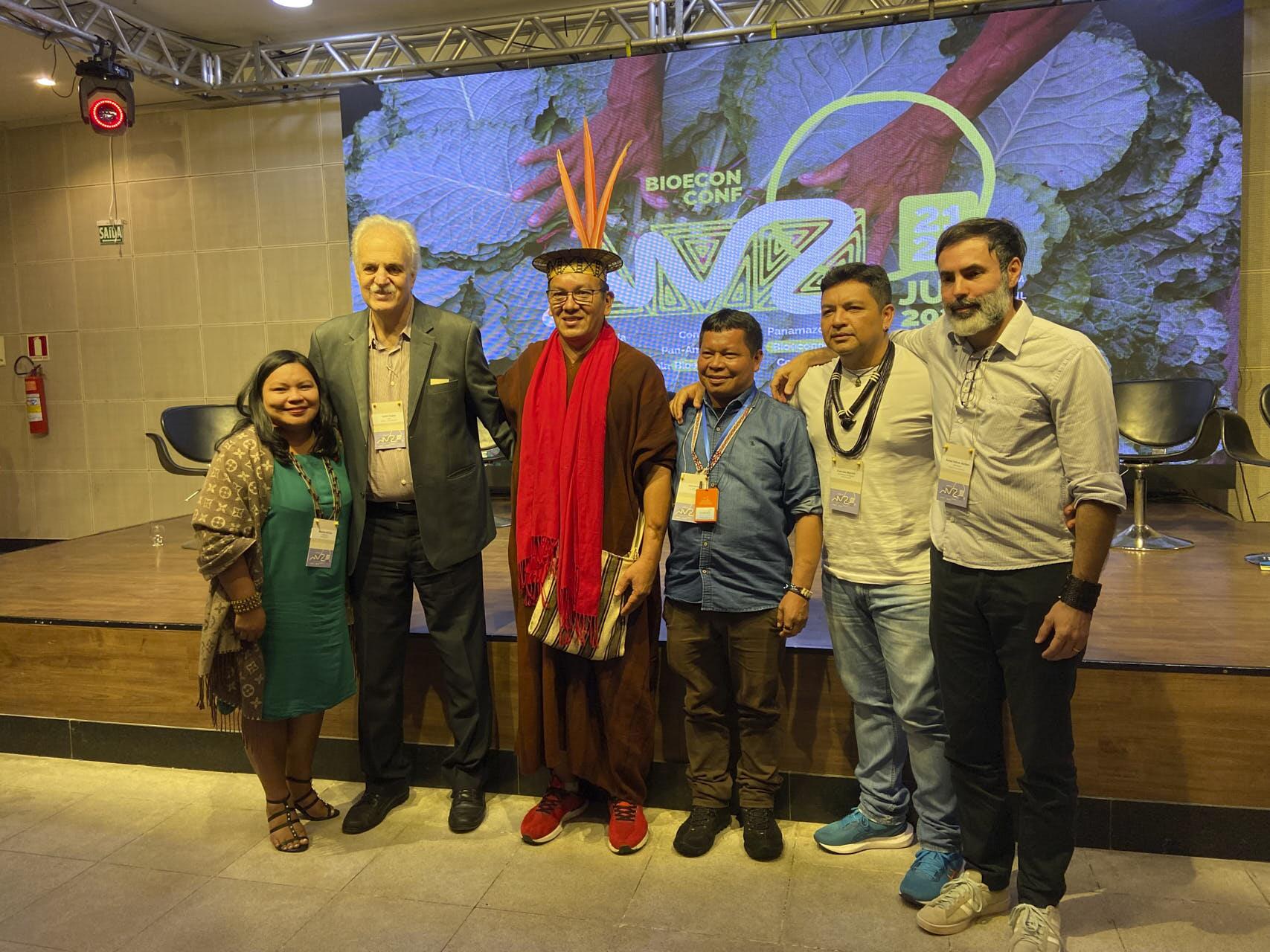
Braulina Baniwa, Carlos Nobre, Francisco Piyãko, André Baniwa, Francisco Apurinã, and Rafael Feltran-Barbieri during the Pan-American Bioeconomy Conference, held in Belém in June. Photo: Claudia Antunes
At the presentation of the NEA research findings in Belém on June 20, Carolina Genin, another coordinator, emphasized that although the study had been supported by the WRI, it was “designed entirely in Brazil,” by Brazilian specialists. “If we want to support disruptive ideas, new models of thinking, we have to look outside the [global] North, where the principal ideas have always been born, but where outlooks are also biased,” says Carolina, who was formerly the climate director at WRI Brazil and now heads the Brazilian arm of the CLUA, the Climate and Land Use Alliance. “We also need to remember that Brazil’s Southeast has a biased outlook,” she adds.
The solution – albeit partial – was to recruit Indigenous researchers, from the Federal University of Pará (UFPA) and from the Amazon Environmental Research Institute (IPAM) to work alongside energy specialists from COPPE, the graduate school in engineering at the Federal University of Rio de Janeiro; academics from the Center for Regional Development and Planning (Cedeplar) at the Federal University of Minas Gerais; and specialists in economic indicators from Fipe, the Institute of Economic Research Foundation, in São Paulo.
Francisco de Assis Costa, a veteran with the Nucleus of Advanced Amazonian Studies at the UFPA, contributed data from his over thirty years of investigations into the historical and current importance of the rural economy in the Amazon, which encompasses family farmers as well as traditional forest communities of ribeirinhos and quilombola communities of descendants of rebellious African slaves. Even though Amazonians were a minority in the group, Costa guarantees they weren’t there to fulfill a quota. “They took us seriously. They listened to us, accepted the research we offered, incorporated it into the study.”
According to the professor, there is another important difference in relation to other recent economic projects: a break with the neoliberal idea that the economy works on its own and self-regulates, demanding only occasional interventions when the market is failing or there is more poverty. “In neoliberal logic, you assume that the system is already codified, but the study recoups the idea that, for big problems, I need to have an equally ambitious understanding of reality,” says Costa. “The study accepts the fact that there is deep structural diversity in the Amazon. There is an economy of agriculture and mining, but it runs alongside another economy, about which people simply say, ‘there are some caboclos [of mixed ethnicity] there,’ but in strategic terms [the latter] carries similar weight.”
Braulina Baniwa, who was born in the Alto Rio Negro Indigenous Territory, in Amazonas, and holds a Master’s in social anthropology from the University of Brasilia, was one of the people tasked with bringing contributions from the Indigenous people’s ways of life to the “new economy.” The anthropologist, who is the executive director of Anmiga, an Indigenous women’s association, feels her participation represented only a first step in the fight to have Indigenous thinking included when planning the future of the Amazon and of Brazil.
Braulina argues that studies on an economy of standing forests and preserved rivers should not stop here, since only a small number of leaders of the region’s 600,000 Indigenous people, across 198 ethnicities, were heard for this one: “What we tried to translate to this study is that Indigenous peoples have their own mode of production, which needs to be recognized and respected,” she says. “At the same time, we say that although we are peoples of the Amazon, we have geographic specificities that must also be considered,” she adds. In this analysis, Braulina highlights the differences between what each native ethnic group collects from nature, produces, processes, uses as food or medicine, and sometimes exchanges with outside markets.
Public investments need to shift direction
The 246-page report starts with a reference scenario where deforestation continues its current trend and there are no restrictions on greenhouse gas emissions. It then establishes the goal of drastically reducing Brazilian emissions. The sixty-seven gigatons (i.e., sixty-seven billion metric tons) of carbon gas emitted over the last thirty years in Brazil, thirty-six gigatons of which were released into the atmosphere from the Amazon, would be cut to 7.7 gigatons from 2020 to 2050, only 1.4 gigatons of which would be emitted from the region. This reduction is compatible with the most ambitious target in the Paris Agreement on climate change, which is to limit the rise in the planet’s average temperature to 1.5 degrees Celsius over pre-industrial levels by the end of the century and to prevent an environmental catastrophe. The researchers concluded that to do this, it’s not enough to eliminate deforestation: the economic model used in the Amazon, much of which is criminal, has to be radically changed.
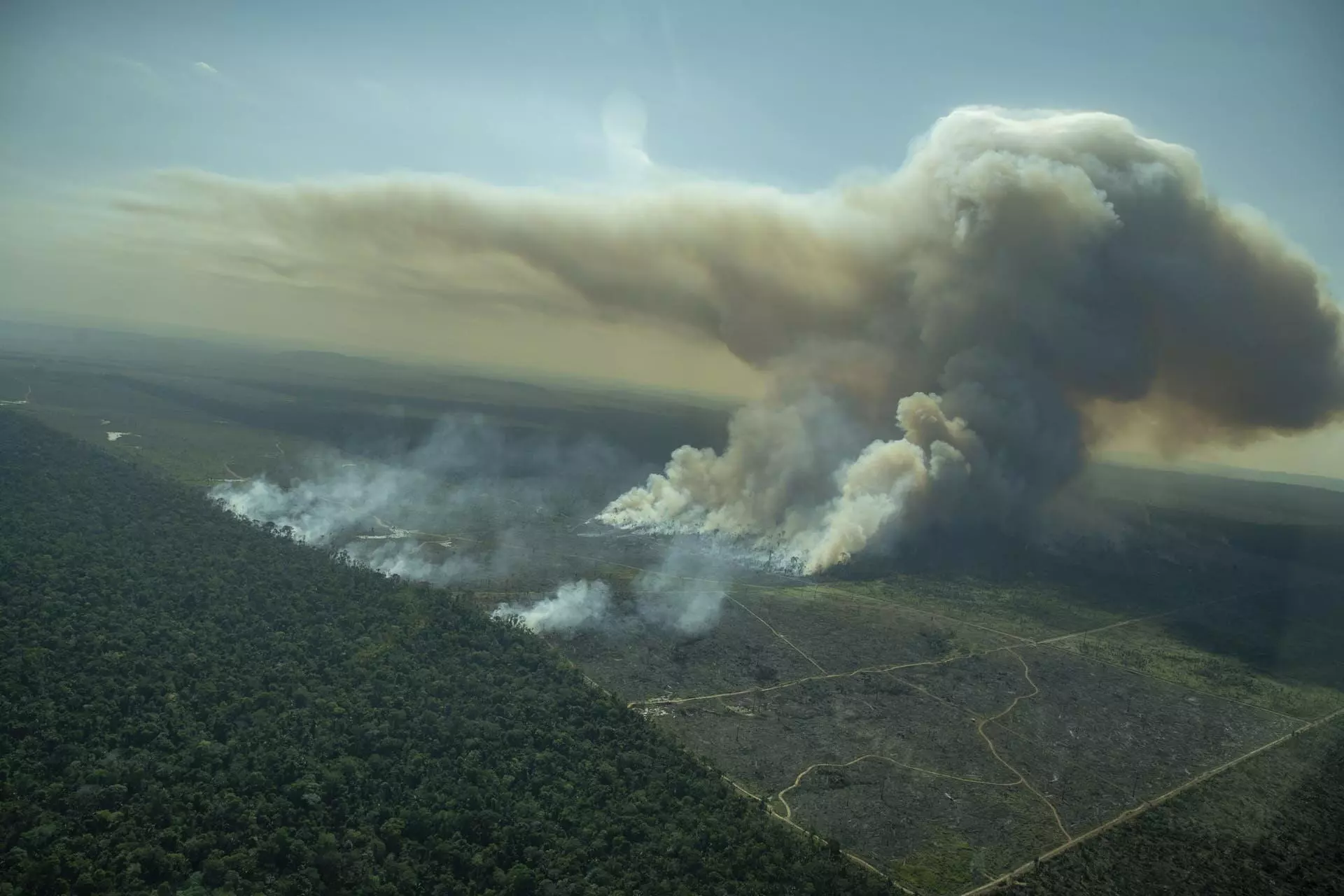
Forest fire in the state of Rondônia in July 2021. To stop the climate crisis, it’s not enough to stop deforestation – the economy must also change. Photo: Christian Braga/Greenpeace
The report needs to be transformed into a menu of concrete measures. First, agricultural and livestock-raising practices must be altered, with the incorporation of more lands replaced by higher investments in existing areas and the employment of more workers. Next, rather than build new hydroelectric dams, solar energy systems should be integrated into current power plants, possibly even occupying current reservoirs. “Hydroelectric plants, including small hydro, have an outsize impact on biodiversity in aquatic systems and increase pollution,” maintains Carlos Nobre. Freight transportation, the biggest polluter, should be partially transferred to waterways. Finally, there should be more investments in forest restoration and the many agroforestry products that already exist locally. In mining, the report proposes to end harmful social and environmental practices and distribute the profits from this activity more fairly among the population.
The study does not look at illicit mining and its ramifications, such as the invasion of Indigenous lands, acknowledging that this would require a separate assessment. It focuses instead on large-scale industrial mining, which in the Amazon accounts for 51% of the industry’s Brazilian production value, with the notable presence of transnational corporations from countries like Norway, Canada, and the United Kingdom, along with Brazil’s own Vale mining concern. The researchers contend that this activity would maintain its importance under the new bioeconomy, especially because reserves of bauxite, aluminum, nickel, tin, copper, iron, and manganese are used to generate clean energy, such as solar panels, electric batteries, and wind turbines. Nevertheless, the report proposes measures to end the negative effects of mining, including deforestation, leakage of tailings, and disorderly growth where mines are located, which leads to pockets of urban poverty and increased crime. Among the proposals is a review of the tax exemptions currently granted to the mining sector and the creation of funds to generate economic alternatives, since this highly mechanized activity creates few direct jobs.
The report concluded that under the NEA scenario, there would be 312,000 more jobs in the region in 2050 as compared to the current trend and that the Gross Domestic Product (GDP), which is the sum of all goods and services produced, would climb by USD 8 billion per year. In addition, using this same comparison, twenty-two million more hectares of forests would be restored and there would be an additional eighty-one million hectares of standing forests. Today, a total of eighty-three million hectares of Amazon rainforest have already been cleared, nearly 20% of its original cover. The project aims to recover most of this.
Of course, this transformation would require a huge investment, calculated at roughly USD 525 billion through 2050 over investments under the current economic model. The report does not offer a precise explanation of where the money would come from, but it does show that the funds exist. The document cites calculations from the Institute for Socioeconomic Studies (INESC), a center in Brasilia specialized in government finances, which says that in the last ten years alone fossil fuels received USD 222 billion in subsidies. INESC also recently pointed out that Vale alone received USD 3.7 billion in incentives in 2021 to mine iron ore in Carajá, Pará. That same year, the company paid USD 885 million in royalties to the state of Pará—only one-fourth of the value it received in subsidies. In agriculture, it’s the same distortion: right now, just 3% of credits distributed in Brazil’s Legal Amazon under a federal agribusiness financing plan known as Plano Safra, which heavily subsidizes large landowners in Brazil, fall within the Low-Carbon Agriculture Plan, where loans are tied to practices that lead to fewer emissions.
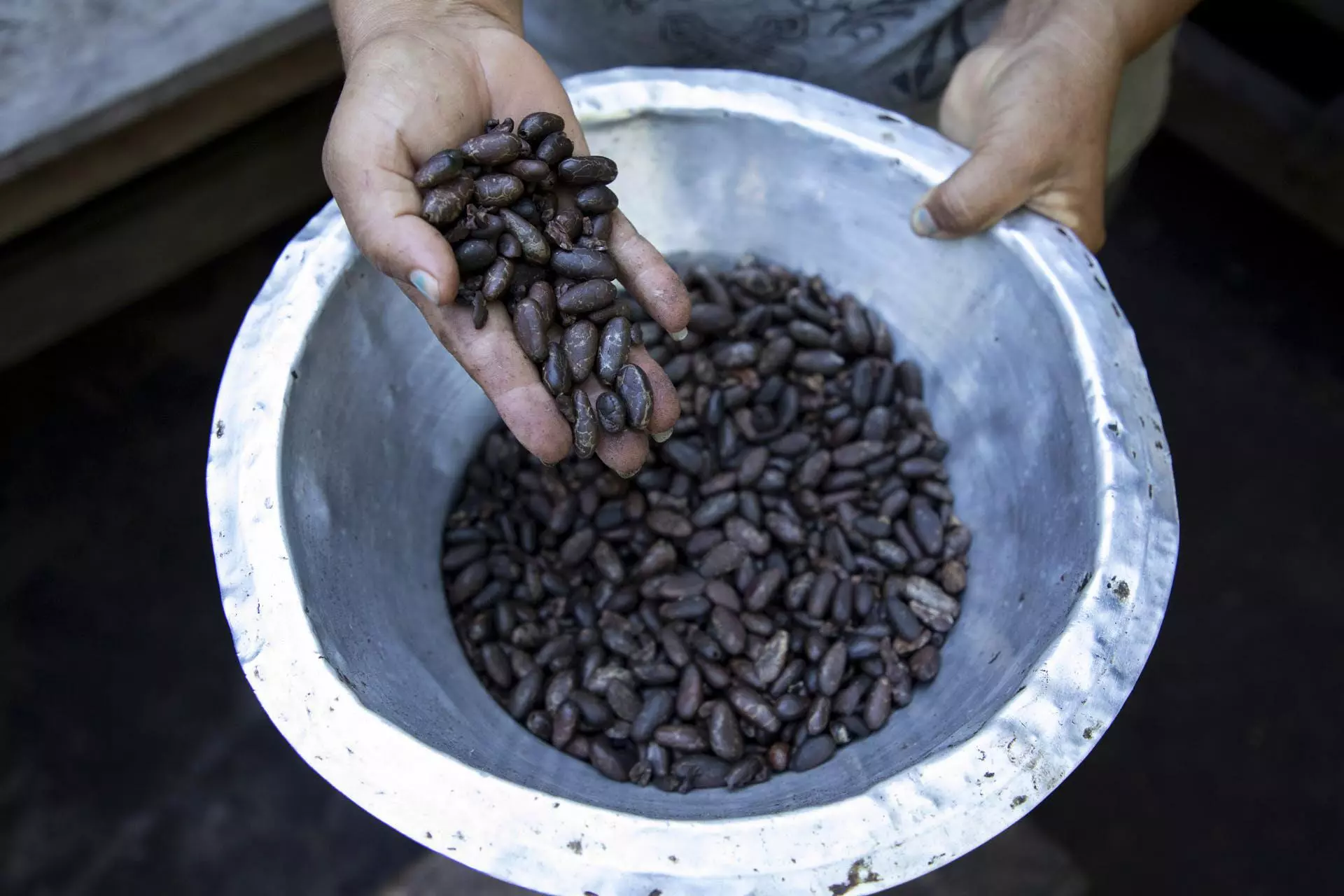
The cacao’s thread of life is also the thread of life for families in the traditional gathering communities that work with these fruits sustainably. Photo: Nilmar Lage/Greenpeace
IPAM’s Eugênio Pantoja reviewed the report’s public policy section and emphasized the urgency of doing so: “All of the constitutional funds [special lines of financing for regional development] for the North need to be reformulated. The Constitutional Fund for Financing the North (FNO), Banco da Amazônia, the Superintendency for the Development of the Amazon (Sudam), and other resources [need to be reformulated] from the new development perspective, because today they are basically financing established chains.” This of course means confronting powerful corporations with massive representation in Brazil’s Congress: last May, the lower house passed a bill extending Sudam incentives for another ten years, exactly as they stand. The bill has yet to reach the Senate. In the past, Sudam played a leading role in one of the biggest corruption scandals involving public funds in the Amazon, and the agency is vital to the illegal land-grabbing schemes still prevalent in the region today, leaving a trail of deforestation and blood.
When considering urgently needed structural changes to the Amazon’s economy, it is important to take into account the so-called “ecosystem services” that the forest provides for free to the region, the country, and the planet. For example, 35% to 45% of the rainfall that currently irrigates central and southern Brazil comes from what are called “flying rivers” formed from the vapor emitted into the atmosphere by transpiration from the rainforest, a process that occurs during photosynthesis. Transporting an estimated volume of 7.3 trillion cubic meters of water annually, this vapor is carried by the wind to other regions of the country, helping form clouds. The forest also stores 120 billion metric tons of carbon above the ground, equal to twelve times the entire world’s annual emissions. The value of these services is not calculated in the study; however, if they were to disappear, the loss would be immeasurable, as Rafael Feltran-Barbieri points out with an example: “Today, 95% of Brazil’s planted area is not irrigated. If we lose the rain, it will be much more expensive to farm using artesian wells, pipes, and electricity to irrigate the land.”
What is the bioeconomy?
When the study was being drafted, there was a heated discussion about the definition of bioeconomy, a term that has grown fashionable in climate discussions and that many have laid claim to, including some within predatory agribusiness. The expression began gaining currency in materially wealthy countries as a reference to the products of energy transition, where fossil fuels would be replaced with fuels produced from agricultural products, like ethanol, even though production of the latter requires enormous monocultures of sugarcane or corn. The term later came to be applied to technologies that reduce carbon emissions from such high-polluting industries as cement and steel.
In the debate on the NEA, it was concluded that the production process must be examined to define what a bioeconomy is. “A 7,000-hectare açaí monoculture is different from açaí collection, because the latter is what drives sustainability, the ability to perpetuate this bioeconomy,” says Feltran-Barbieri. So the decision was made to adopt the term “bioeconomy of sociobiodiversity,” referring to people who live off the diversity that nature offers as part of a system that ensures continued reproduction of substantial ecological variety. Harley Silva, who has a PhD in economics from Cedeplar and has worked with Francisco Costa at the UFPA since 2017, interprets this concept: “The fisherman is married to the seed gatherer, who is the mother of the nut gatherer. That means the community participates in this process, which is very much based on the region’s ability to offer renewable products, as well as on choice, on a liking for the type of product, on diet.” In the region, with few exceptions that have gained scale, such as açaí, this economy remains more connected to local consumption habits than to demand from outside markets.
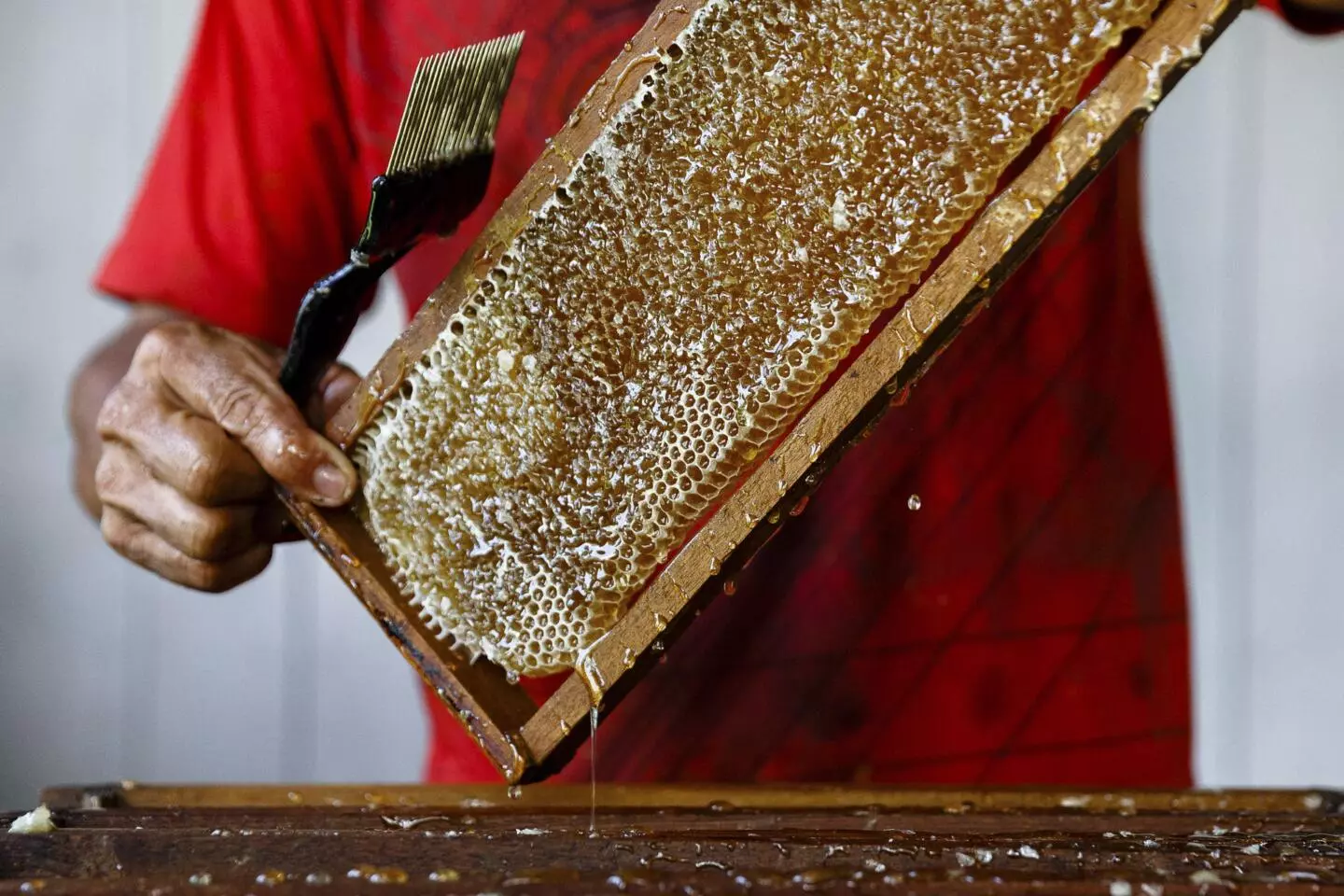
Harvesting honey at an extractive community on the Bailique archipelago, state of Amapá. Photo: Diego Baravelli/Greenpeace
Francisco Costa himself, who is a native of Rio Grande do Norte and came to Pará in 1972, didn’t think in terms of the bioeconomy when he began his doctoral research in the 1980s. At the time, products typical of the rural economy in the Amazon – like açaí, cupuassu, Brazil nuts, babassu, and andiroba – began to disappear from national economic figures, giving way to crops from the region’s large monoculture farms. Little by little, the forest fruit chain, from gathering to processing, sale, and consumption, no longer made it into the books. Together with his research group on agrarian and sustainable development in the Amazon, the professor went into the field to calculate this value, in what he calls a “revelatory effort.”
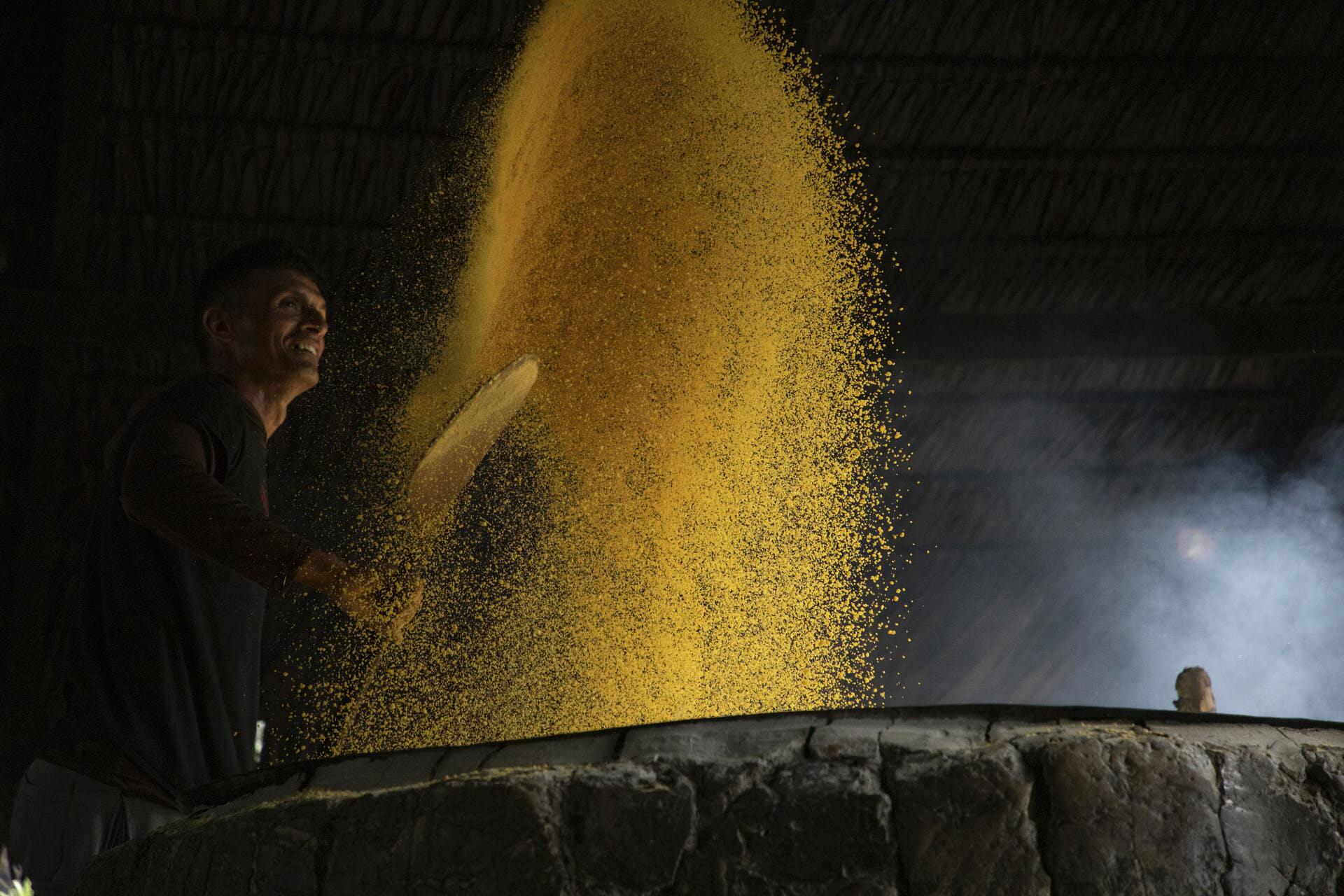
Subsistence economy, no – existence economy. The picture shows cassava flour being produced near the Manicoré River, state of Amazonas. Photo: Nilmar Lage/Greenpeace
This involved everything from going to communities and directly asking questions – whom do people buy from, to whom are sales made, at what price – to examining individual microentrepreneurs to see which ones work in activities related to the bioeconomy, such as independent beekeepers, Brazil nut processors, and fruit pulp manufacturers. With the indicators from this ongoing research study and based on just thirteen products that could be measured across the entire chain, the UFPA specialists estimated the value of this standing forest economy (which obviously does not include timber) to represent an annual GDP of USD 2.5 billion. The NEA report calculates that, with incentives, this sector could be worth USD 8 billion and employ 947,000 people in 2050, compared to today’s 334,000 jobs.
Costa refutes the idea that the “bioeconomy of sociobiodiversity” is an “aberration,” the remnant of a subsistence economy marked by poverty and destined to disappear, a notion still held by many economists and politicians fond of the old developmentalism. “It is a family-based economy, which has on average, over history, guaranteed a respectable level of reproduction,” he says. Traditional communities in the Amazon usually reject the concept of a “subsistence economy” – for them, the correct expression is “existence economy.” In communities that have sustained themselves as part of nature, the concepts of rich and poor are radically different from those used by economists of different ideological streams of thought.
What does wealth and poverty mean in nature?
UFPA research on the rural economy does not include the types of production used in Indigenous territories. “[The Indigenous] organize themselves in a different way, extensively; their social structure is different, and economists find this hard to deal with,” says Francisco Costa. Braulina Baniwa isn’t even sure it makes sense to measure the economy of Indigenous peoples: “Bioeconomics is an external discussion; it’s not something within our territory. That’s another question—how we see ourselves in this place.” What she sees is that, on the one hand, there are ways of producing inside Indigenous territories while, on the other, a relationship does exist with the market, which often wants to impose its own approaches and rules. “The market needs to consider and value our mode of production. We’re not robots producing large quantities in a short time. We don’t work by the hour; we have our own rhythm of life, which must be valued, because these are the people who keep the forest standing,” she argues.
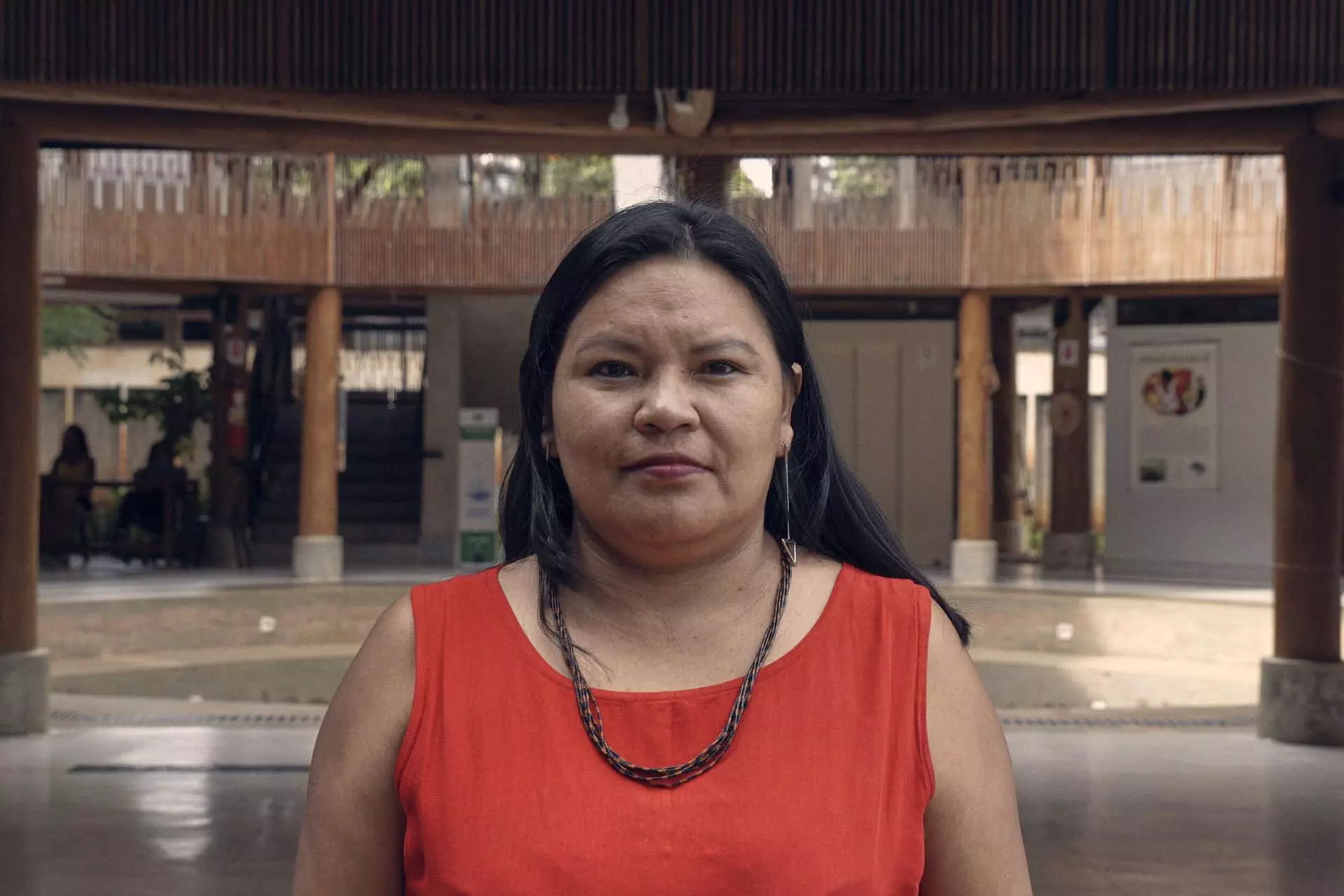
The anthropologist Braulina Baniwa says “We don’t work by the hour; we have our own rhythm of life, which must be valorized, because these are the people who keep the forest standing.” Photo: Cristian Wari’u
Indigenous leaders make it a rule to never decide anything without consulting their people. For the NEA study, Braulina and other researchers, like the anthropologist Francisco Apurinã, surveyed forty-two Indigenous leaders from nine states in the region, including thirty-seven who were interviewed at the 2022 Free Land Camp in Brasilia. Although the sample size was small, responses reflected a wide variety of productive arrangements and divisions of labor. In some cases, interviewees drew a clear distinction between planted and gathered products, whereas others did not even mention the difference. Some of the interviewees expressed interest in obtaining more resources to facilitate exchange with the market.
For Braulina, it might be less important for the study to talk about “Indigenous bioeconomics” than to highlight the importance of demarcating and protecting Indigenous territories. “We survive without money; we are forest peoples. We just need healthy fish, healthy rivers, demarcated land,” she says. “Our life isn’t based on money. Our life is based on space, on land, and it is our relationship with our spaces that must be secure. That’s why demarcation is the key issue if we are to continue existing.”
Like Braulina, Francisco Apurinã left his land—in this case Camicuã, Acre—to pursue a graduate degree in Brasilia, where he earned his doctorate. For Apurinã, who also underscores the importance of Indigenous territories, the current troubles besetting these lands, like the emergence of crime, are “the product of clashes between Indigenous knowledge and dominant Western knowledge.” He feels Indigenous peoples derive their “strength, wisdom, knowledge, and spiritual nourishment” from sacred sites. “All these criminals are extremely disrespectful of such places,” Apurinã said, “When one of these places is destroyed, spiritual agencies carry off all of our wealth, and we are left alone.”
Land is not a commodity
No discussion of structural change in the Amazon can circumvent the land issue, and not just the matter of Indigenous lands. The NEA report shows, for example, that the region’s unequal land distribution pattern mimics concentration patterns in the rest of Brazil, despite higher levels of land-grabbing and deforestation in the Amazon. According to the document, this “refutes the rhetoric that deforestation is a necessary evil in the fight against land inequality”—a reference to the thesis, common among agribusiness supporters, that land settlement by small farmers is responsible for greater forest destruction.
The report also showed that 83% of deforestation in the Legal Amazon can be traced to demand from other regions of Brazil or abroad for livestock, monocultural crops, or minerals. Under current economic logic, the study says, “the region is a large depositary of land that supplies low added value inputs to the national and international economy, exporting primary products and purchasing qualified goods and services with higher added value.”
In addition, and perhaps more importantly, under the current system in the Amazon, deforested land is not only an asset required to produce cattle, soybeans, or timber—it is a commodity in and of itself. Harley Silva, of the UFPA, says that “it works like a store of value: I cut down the forest and then wait around because someone will come along during a commodity boom and say: I’ll buy it; I’ll lease it.”
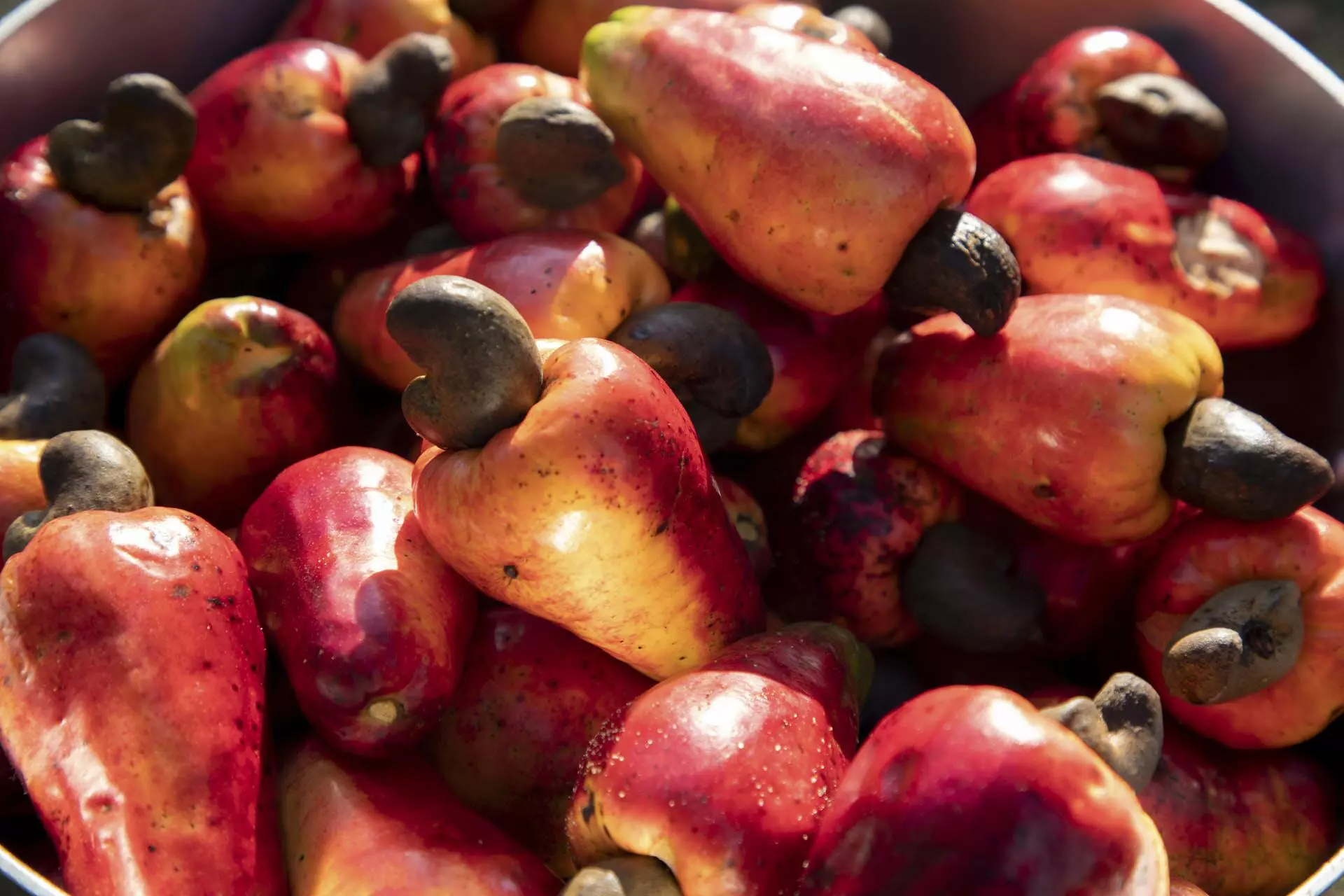
Cashew nuts are among the forest products that drive the economy in the Manicoré River region, state of Amazonas. Photo: Nilmar Lage/Greenpeace
For Francisco Costa, talking about land-grabbing and illegality isn’t enough to explain things. “Like any market, it only exists when based on a relationship of trust. That’s why the legality argument is rather naïve. You don’t need formal legality; you need symbolic trust among those operating on the market,” he says. “The fellow going after land knows the land title is fraudulent, but he [also] knows nobody will ever discover the fraud, or the chances are minimal, and so he accepts the title as genuine.”
In recent decades, experience has also shown that the government and Congress eventually legalize this fraud through “land regularization” laws. This is what happened in 2007 under the second administration of Luiz Inácio Lula da Silva (Workers’ Party) and again in 2017 under Michel Temer (Brazilian Democratic Movement). Next, far-right former president Jair Bolsonaro—who is currently a member of the Liberal Party but ineligible to run for public office—tried unsuccessfully to push through a law dubbed the Land-Grabbers Provisional Measure, which would have made it easier to legalize illegally occupied public lands.
Everyone knows that unless this market of treeless lands is abolished, it will be impossible to build a standing forest economy in the Amazon. Legal instruments exist that could fix the situation but “first you have to make the political decision to do it,” specialists insist. Ideally, the chain of title transfers would be checked in real time. The UFPA, in conjunction with the Public Prosecutor’s Office, set up a system for verifying titles issued by the state of Pará. However, according to Francisco Costa, the initiative ran into problems in the justice system and was never put in practice.
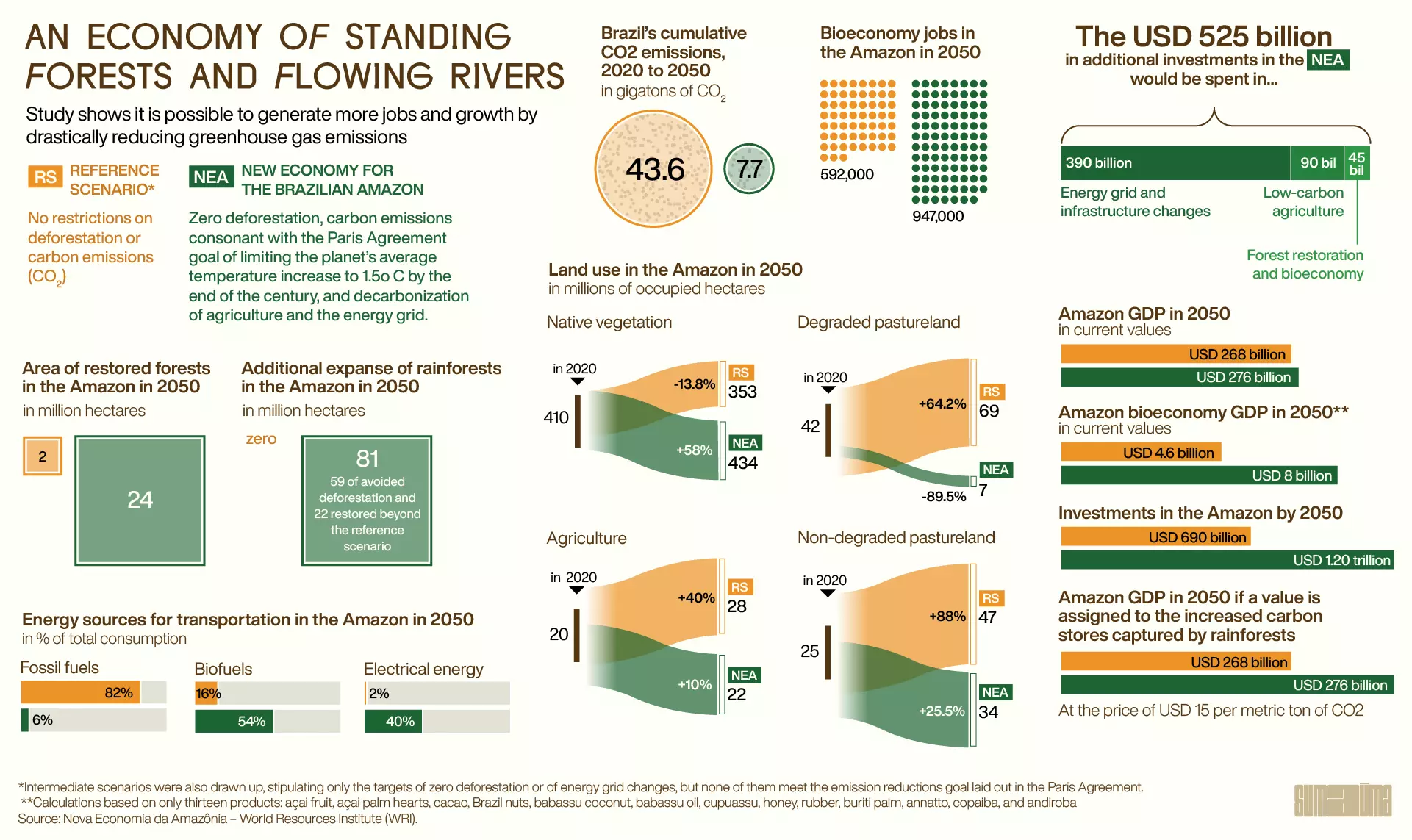
Infographic: Rodolfo Almeida/SUMAÚMA
Will the NEA get off the drawing board?
Given the power of those who win big in the short term by keeping things as they are, it is doubtful whether the report’s recommendations will be enforced on the ground in the Amazon. At the time the research got underway, no one knew that COP30, the 30th UN Climate Change Conference, would be held in Belém in 2025. The event is now seen as an opportunity for transformative proposals like this to have a stage. In early August, the capital of Pará will host the first summit of Amazon rainforest countries, focused on the region.
Marcello Brito, who defines himself as an “agro-environmentalist” and who has since April served as executive secretary of the Legal Amazon Consortium, formed by the states in the region, said there isn’t much time left to decide. “This study should be called a new mental model for humanity,” he suggests. “We have the challenge of practically starting a new country or new region in a tight window of opportunity, a window of survival,” he says. Brito pointed out that the European Union’s new ban on imports of various deforestation-linked commodities will enter effect in late 2024, and this is a huge market for Brazilian agriculture.
João Paulo de Resende, special advisor to Finance Minister Fernando Haddad, who was present in Belém when the report was released, said it is a “hot” topic in Brasilia. “What is different now is that we recognize that if the government does nothing and just lets economic agents act, things will continue along the path of the reference scenario,” he stated, referring to the basis of comparison used in the study, where there are no restrictions on emissions and deforestation follows current trends. Resende also raised the matter of political will. “The hard part isn’t finding the instruments, it’s having the will to take up the fight,” he argued, adding that his ministry “is here to say yes.” He mentioned the administration’s plan to support the transition to a low-carbon economy, but there is no deadline for its finalization.
Indigenous educator André Baniwa, who helped edit the NEA report, declared himself optimistic. “[The plan to hold] COP here in Brazil is mobilizing a lot of people, inspiring changes in outlook,” he said. He looks forward to the day when the Brazilian Constitution, whose preamble pledges to guarantee the well-being of all Brazilians, will also embrace the concept of “well-living,” which incorporates the idea of harmony between humans and nature and all its beings. André is pointing the way to a utopia based on ecological revolution, supplementing the numbers presented in the study led by Carlos Nobre—hand in hand, the two approaches have the power to save the forest and guide the path to a living future.
Fact check: Plínio Lopes
Spell check (Portuguese): Elvira Gago
Translation into Spanish: Julieta Sueldo Boedo
English translation: Sarah J. Johnson and Diane Whitty
Photography editing: Marcelo Aguilar, Mariana Greif and Pablo Albarenga
Page setup: Érica Saboya
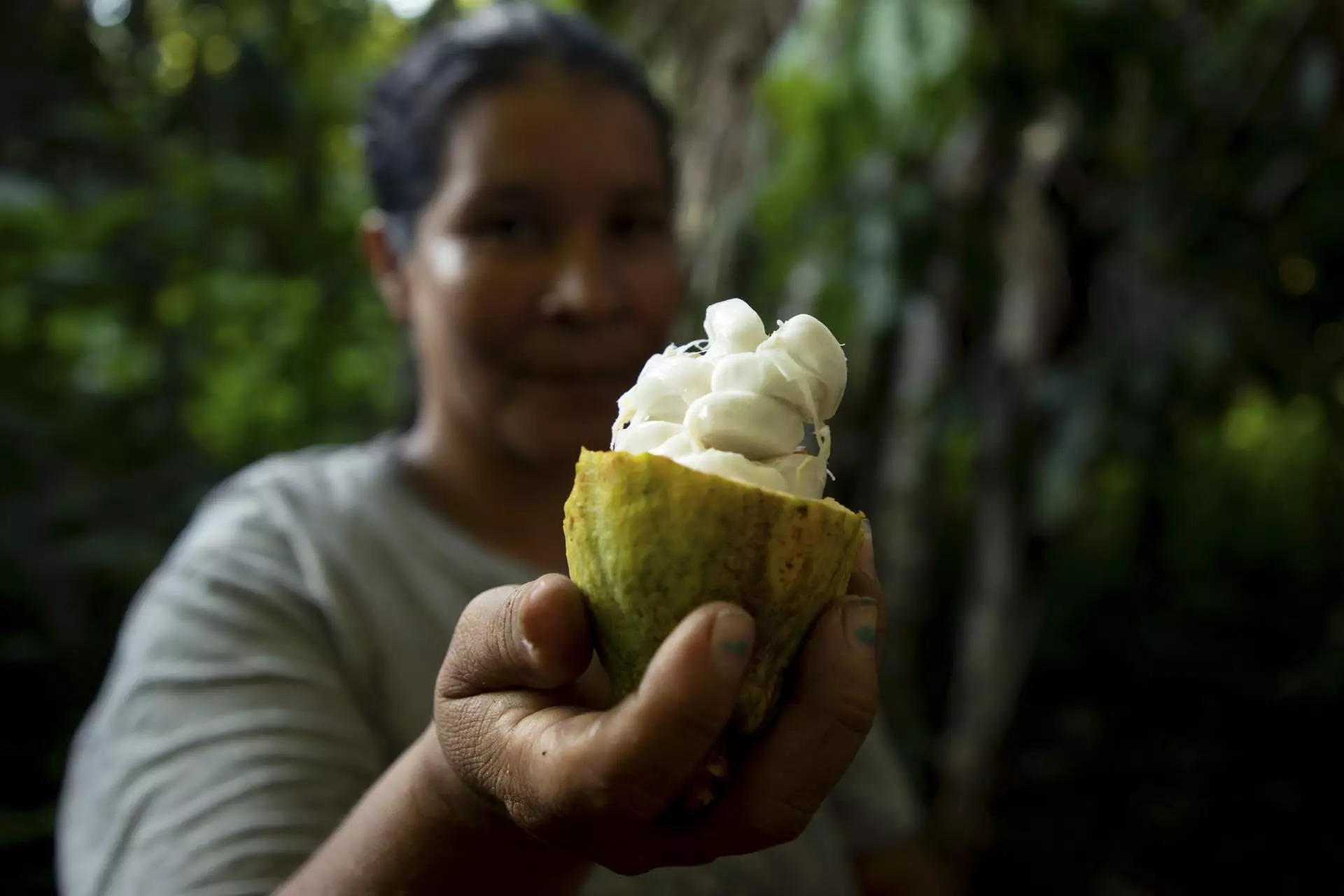
A beiradeira – woman from a traditional forest community – holds up a fruit from a cacao tree. Among other things, sociobiodiversity is about working with local products in an economy based on community and sustainable development. Photo: Nilmar Lage/Greenpeace





